瓷器介绍英语ppt
瓷器英文PPT
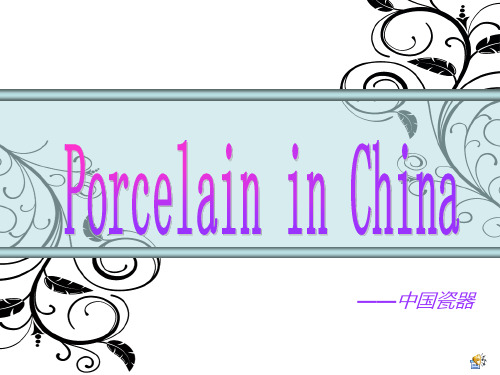
景德镇
• Jingdezhen is one of the three porcelain ['pɔːs(ə)lɪn] capitals of China.
Jingdezhen porcelain is beautiful, rich variety, adornment [ə'dɔːnm(ə)nt]装饰, Jingdezhen in one incidence is described to be “as white as jade, as thin as paper, as bright as a mirror.” It makes a bell-like sound when struck.(白如 玉、明如镜、薄如纸,声如磐)
and meaningful
Famile-rose porcelain粉彩瓷
Famile-rose porcelain,also called soft decorative porcelain, which is one of the four traditional porcelains of Jingdezhen, is a kind of porcelain decorated mostly by famile-rose.
Blue and white porcelain
Blue and white porcelain is elegant, bright, gorgeous, and long-lasting. The white pottery and porcelain decorated under the glaze with a blue pigment. Its unique artistic connotation is the perfect joint of traditional and modern arts. :青花 瓷清雅、明净、高贵,白底蓝彩、千年 如新,以其旺盛的生命力和独特的美学 内蕴荣立于陶瓷艺术之中,成为现代与 传统结合的完美点
瓷器介绍PPT翻译
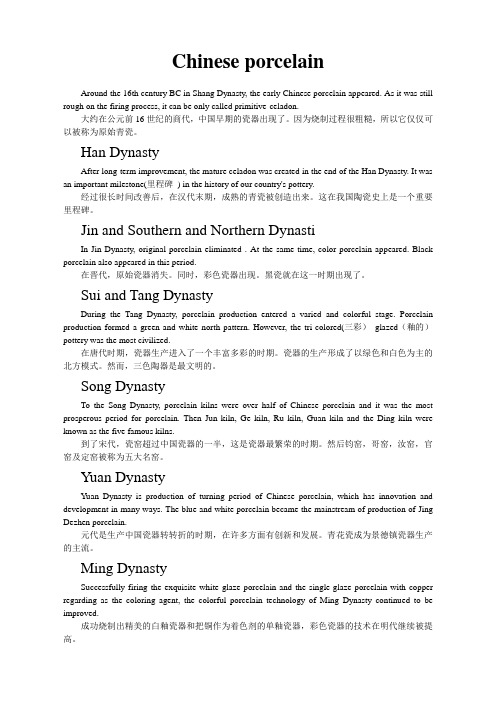
Chinese porcelainAround the 16th century BC in Shang Dynasty, the early Chinese porcelain appeared. As it was still rough on the firing process, it can be only called primitive-celadon.大约在公元前16世纪的商代,中国早期的瓷器出现了。
因为烧制过程很粗糙,所以它仅仅可以被称为原始青瓷。
Han DynastyAfter long-term improvement, the mature celadon was created in the end of the Han Dynasty. It was an important milestone(里程碑) in the history of our country's pottery.经过很长时间改善后,在汉代末期,成熟的青瓷被创造出来。
这在我国陶瓷史上是一个重要里程碑。
Jin and Southern and Northern DynastiIn Jin Dynasty, original porcelain eliminated . At the same time, color porcelain appeared. Black porcelain also appeared in this period.在晋代,原始瓷器消失。
同时,彩色瓷器出现。
黑瓷就在这一时期出现了。
Sui and Tang DynastyDuring the Tang Dynasty, porcelain production entered a varied and colorful stage. Porcelain production formed a green and white north pattern. However, the tri-colored(三彩)glazed(釉的)pottery was the most civilized.在唐代时期,瓷器生产进入了一个丰富多彩的时期。
景德镇瓷器英语演讲课件
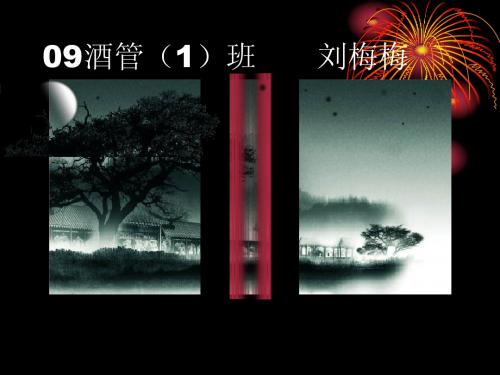
刘梅梅
孙菲Sophy
Porcelain capital of China ——jingdezhen
Jingdezhen is located in northeast of jiangxi province.
瓷 器
The four famous porcelain of jingdezhen
Thank you for your listening!
青花玲珑瓷属景德镇四大传统 名瓷之一,又称“米通瓷”, 外国朋友则称之为“嵌玻璃的 瓷器”。这一产品是在同一件 瓷器上,既绘有青翠欲滴的 “青花”,又布有碧绿透明的 “玲珑”,二者互相衬托,相 映生辉。
Exquisite workmanship
famille rose porcelain
粉彩亦称软彩,它画工细腻工整, 画面充满着浓郁的民族特色,线条 纤细秀丽,形象生动逼真,色彩粉 润柔和,富有立体感,深受国内外 朋友喜爱,人们称它为“玫瑰族瓷 器”、“东方艺术的明珠”。
Blue and white porcelain developed and spread quickly after its emergence.
Blue and white with rice pattern porcelain
The bule and white porcelain with rice pattern is also called “Mitong” in Chinese, mean ”the transparent rice pattern”.
Blue and white porcelain (青花瓷) Blue and white with rice pattern porcelain (青花玲珑瓷) Famille rose porcelain (粉彩瓷) Colored galze porcelain (颜色釉瓷)
瓷器英文PPT

清雍正 柠檬黄地洋彩浮雕花鸟宝瓶纹六方瓶
Qing Emperor Yongzheng
Poly 2009 Spring Auction Price RMB : 67,760,000
Qing Emperor Guangxu 粉彩九桃玉壶春
Poly 2009 Spring Auction Price RMB : 60,000~90,000
Qing Emperor Jiaqing 黄地粉彩花卉高足盘 Poly 2009 Spring Auction Price RMB : 224,000
Qing Emperor Qianlong 白地粉彩八宝纹炉 Poly 2009 Spring Auction Price RMB : 224,000
Famille-rose porcelain
“Pearl in the East”---pastel drawing beads 有“东方明珠”之称的粉彩瓷珠
Qing Emperor Qianlong
清乾隆 粉彩七珍象 马
Poly 2009 Spring Auction Price: RMB 403,200
Qing Emperor Daoguang 黄地粉彩花卉碗(一对) Poly 2009 Spring Auction Price RMB : 224,000
Glowing porcelain玲珑瓷
Glowingporcelain, as blue and white porcelain,color glazeporcelain, famile-rose porcelain,is one of four tradition and famous china.
Color glaze porcelain
介绍陶瓷(英文版)
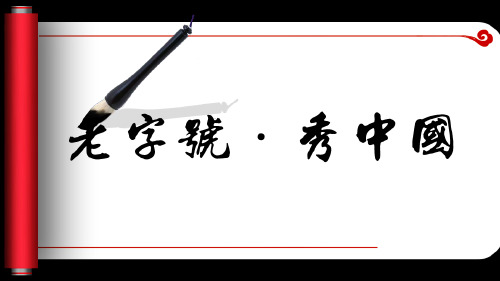
Ming Plain Tri-colored Glazed Porcelain
During the Zhengde reign of the Ming Dynasty (1368-1644), a type of colored-glazed porcelain featuring three major colors -- yellow, green and purple -became very popular in Jingdezhen, Jiangxi Province.
China, as one of the world's most ancient civilizations, has made
a multiple of contributions for the advancement and improvement of
human societies.It is fair to say that ceramics history is a very
Jun Kiln 钧窑
Ding Kiln 定窑
Dehua Kiln
Shiwan Kiln
Jiangyang Kiln
Yixing Kiln
Xing Kiln
Cizhou Kiln
Changsha Kiln
THANKS !
选择=结果
汇报结束 谢谢观看! 欢迎提出您的宝贵意见!
Blue and White Porcelain of Yuan Dynasty
The Yuan Dynasty (1271-1368) is a key period for the development of the firing techniques of the Blue and White Porcelain in China.
陶瓷英文ppt
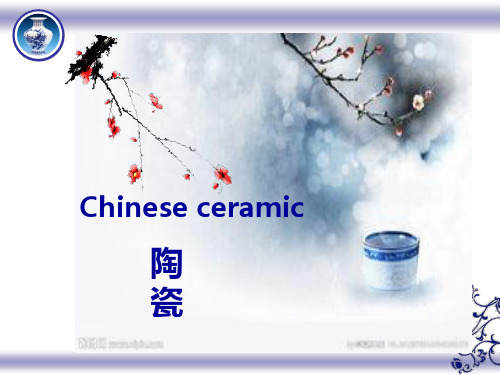
陶 瓷
Ceramic (陶瓷):
Chinese ceramic ware(制品) shows a continuous development since the pre-dynastic periods, and is one of the most significant forms of Chinese art.
青花瓷清雅、明净、高贵,白底蓝彩、 千年如新,以其旺盛的生命力和独特的美学 内蕴立于陶瓷艺术之中,成为现代与传统结
合的完美点。
Color-glazed pore-rose Porcelain(粉彩瓷)
Glowing porcelain(玲珑瓷)/ling • 又译lu为nrigce-pattern decorated porcelain, “米通瓷”
The white pottery in the Shang dynasty is the foundation of original porcelain. Porcelain is used as raw materials and the sintering (烧结的)temperature reached 1000℃ above,
• Early wares
Pottery has a long history in China. It was invented in the early New Stone Age.
• Xia dynasty
灰陶grey pottery、夹砂陶sandy clay
• Shang and Zhou dynasties
For example: terra cotta warriors and horses (兵马 俑)
关于瓷器的英语PPT展示

——by Wang Zhuo、Wang Yao、Ouyang Ran、Yu shanshan/Zhang Zhaosong、Zhao haoLet’s Begin Our Trip at Jingde ZhenJingdezhensightseeingJingdezhen. is very famous as “the capital of porcelain" It's China's main porcelain-making center since the Song dynasty, as early as 1712 needed to keep three thousand kilns fired day and night.Three main kinds of porcelain•hard-paste porcelain(硬瓷)•soft-paste porcelain(釉瓷)•bone china(骨瓷)The blue and white porcelain•Blue and whiteporcelain enameltransparent water, tires,white light thin body ofporcelain body apply toblue, elegant decoration,pure and fresh vitality.Once appear blue rage,become the writings ofjingdezhen tradition.Tri-coloured glazed pottery of theTang DynastyThe Histroy of PorcelainNeolithic age(石器时代)In the history of Chinese ceramics, porcelain derived frompottery(陶)and appeared later. In the early years,people have made splendid achievements in ceramic fieldespecially in Yellow River and Changjiang River drainagearea where a lot of potteries and pottery fragments in theNeolithic age were unearthed at historical sites. Some ofthem were not only commodities, but also artworks suchas ancient painted pottery and pottery figurine(塑像).With the development of pottery industry, the previousclay-strip forming technique has been changed to throwclay(粘土)method,while advanced side-fired kiln andshaft kiln replaced ground firing. People at that time alsogot some experience on how to control the temperature.The highest firing temperature had reached 1100℃, whichwas quite close to the firing temperature between potteryand porcelain. In the early period of Yin and ShangDynasty,the appearance of white pottery whose materialDong Han、W ei、Jin In Dong Han Dynasty, the appearance of mature celadon(青瓷)in Yue kiln was a milestone in the history of Chinese ceramics. Wei Dynasty, Jin Dynasty, the South and North Dynasty were just the seedtime. At that time, celadon played an important role in ceramics, which was widely fired. In the mean time, a small quality of black glazed(上釉的)porcelain and white glazed porcelain were discovered. Because of the unity of different nations and the introduction of Buddhism(佛教), the ceramic style became various duringSui and Tang Dyansty In Sui and Tang Dyansty, the Chinese politics, economy, culture and trade became unprecedentedly prosperous, which promoted the progress of ceramics industry, the expansion of ceramic market and later formed the situation of "celadon in south and white porcelain in north."(南青北白) Celadon was the main product of South China. Yue kiln was the typical representative with high artistic value. The tyre(胎)was light, thin and compact; the glaze layer(釉面)was transparent and exquisite. White porcelain of Xing kiln in Tang Dynasty was the representative of "North white". The degree of whiteness in both body and glaze was good. Its body was compact and usually had a ringing sound when being knocked.tri-coloured glazedpottery of the TangDynastySong Dynasty Song Dynasty was the third prosperous period of the feudal society. Technology, culture, art and handicraft were highly developed. The ceramic industry was flourishing too. Porcelain kilns with regional feature spread all over the country, which formed the layout of "six kiln factions(派系)" and "five famous kilns". "Six kiln factions" were Ding kiln faction, Jun kiln faction, Yaozhou kiln faction, Cizhou kiln faction, Longquan kiln faction and Jingdezhen kiln faction. "Five famous kilns" were Guan kiln, Ru kiln, Ge kiln, Ding kiln and Jun kiln. After the establishment of Guan kilns in Song Dynasty, different artistic styles were formed in folk kilns.The famous porcelain city Jingdezhen grew up in Yuan Dynasty, and it was known for its blue-and-white porcelain, underglazed red porcelain and egg white porcelain.Ding kiln Guan kilnMing and Qing Dynasty In Ming and Qing Dynasty, Chinese porcelain art took on a brilliant and splendid look after thousands of years of development. Ancient painted porcelain became prosperous: such as blue-and-white, wu-cai, dou-cai, plain tri-color, underglazed san-cai, enamel color, fen-cai and so on. The painted porcelains in Ming and Qing Dynasty merged the ceramic art into a whole and gradually became perfect. Single color glaze were of various kinds: sacrificial red glaze, sacrificial blue glaze, Lang kiln red glaze, Jiangdou red glaze, yellow glaze, peacock green glaze and so on. Besides, new progress has been made in the making of ceramics. For example, wheel jiggering(用转模车制陶器)has replaced bamboo knife jiggering. Moreover, blowing glaze(吹釉)technology began to be used. From then on, the quality and quantity of porcelain increased rapidly. The ceramic industry of Ming and Qing Dynasty reached theA history of Chinese ceramics(制陶术), is an image of Chinese history, Chinese national culture.Thanks!。
介绍陶瓷(英文版)
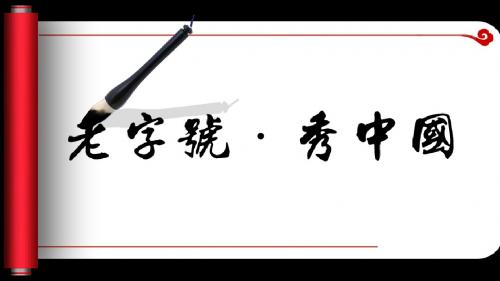
7、The Han Dynasty( 206BC-220AD): Multi-colored(综合彩)glaze was also introduced in . 8、The Sui Dynasty(581-618):Greater variety and color.
9、TheTang Dynasty( 618-907 ) :More color was applied them in ,the invention of potters who introduced white, yellow, blue, green, brown, purple and so on.
China, as one of the world's most ancient civilizations, has made a multiple of contributions for the advancement and improvement of human societies.It is fair to say that ceramics history is a very important part of China's history. The word "china" clearly shows that the country is the "home of pottery(陶器) and porcelain(瓷 器).&graphy and painting
Pottery and porcelain art has a lot in common with ancient Chinese painting in terms of artistic essence, characteristics, and expressive ways. Both art forms require the artists to delve deep into life and reflect it in an artistic way.
Chinese Porcelain——中国瓷器——英语ppt
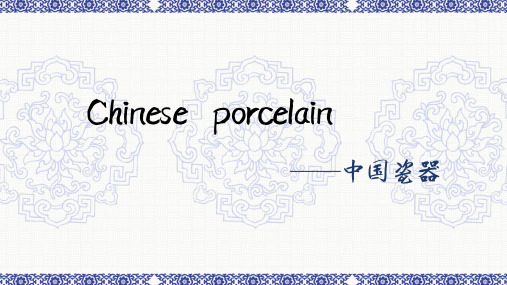
2. Pulling: Drop the mud ball into the center of the turntable of the trolley, bend and stretch it according to the technique, and draw the basic shape of the body.
第一,瓷器的胎料必须是瓷土的。瓷土的成分主 要是高岭土和化妆土,并含有长石、石英石和莫 来石成分;含铁量低。经过高温烧成之后,胎色 白,具有透明或半透明性,胎体吸水率不足1%, 或不吸水。
Secondly, the body of porcelain must undergo high-temperature roasting at 1200 ℃ to 1300 ℃ to possess the physical properties of porcelain. Porcelain clay varies from place to place, and the firing temperature also varies, so the sintering should be taken as the standard.
2、拉坯:把泥团摔在辘轳车的转盘中心, 顺着手法的屈伸收放,拉制出坯体的基本模 样。
3. Printing blank: The shape of the mold is formed by rotary cutting according to the inner curve of the blank body. The half dried blank is covered on the mold seed, evenly pressed against the outer wall of the blank body, and then demolded.
中国瓷器介绍英文版演示教学

中国瓷器介绍英文版Chinese PorcelainsGood morning, everyone!Today, I want to tell you something about Chinese Porcelains. China is the hometown of porcelains. It’s an important creation of the working people of Han nationality. Porcelain developed from Pottery. The earliest porcelain appeared in Shang and Zhou dynasty about3,000 years ago. The true meaning of the Chinese porcelains produced in the Eastern Han Dynasty.In The Middle Ages, accompanied by Chinese Porcelains export, Chinese began to known in the world as “Country of Porcelain”. By the Song Dynasty some seven centuries later, the porcelain industry was flourishing. Ming andQing Dynasty was the heyday of Chinese Porcelains. The quantity and quality of porcelain production has reached the peak. Jingdezhen as the “Porcelain Capital” status has been established.Welcome to Jingdezhen Museum. Jingdezhen is located in northeastern Jiangxi. Jingdezhen porcelain is the pearl in the treasure house of Chinese art and culture. In its long and glorious history, a brilliant art and craft has been handed down. The feature of Jingdezhen Porcelain was described as being “as white as jade, as thin as paper, as bright as a mirror, with a sound as clear as a bell.” The four traditional porcelains are Blue and white porcelain,Glowing porcelain, Color glaze porcelain, and Famille-rose porcelain.Blue and white porcelain has a white base with blue designs. Blue designs are applied to the white body of the porcelain, making it appear elegant, fresh and full of vigor. Its unique artistic connotation is the perfect combined of traditional and modern arts.Glowing porcelain is also called “Mitong” in China. Craftsmen carve out many regular “delicate eyes” in the porcelain body, and then fire these holes with the glaze into the bright hole. European called it as “the transparent rice pattern”.Jingdezhen’s colorful glaze is famous for all over the world. It contains a long tradition, and is gradually concluded by our ancestors during the long-time producing and experimenting. Our ancestors had accumulated rich experience in the long time producing and struggling.Famile-rose porcelain also called soft decorative porcelain, which is one of the four traditional porcelain of Jingdezhen. As known as soft colors, is over glaze decoration of porcelain wares. “A manwithout porcelain is not noble. A room withoutporcelain is indecent.” Porcelain is ubiquitous in our culture.Thank you for your attention. Next, we will have a lunch in a five star hotel.彭雅玲。
介绍陶瓷(英文版)

Jun Kiln 钧窑
Ding Kiln 定窑
Dehua Kiln
Shiwan Kiln
ห้องสมุดไป่ตู้
Jiangyang Kiln
Yixing Kiln
Xing Kiln
Cizhou Kiln
Changsha Kiln
THANKS !
Noted Ceramics
White Pottery
White pottery is a kind of pottery whose outside and inside are all white. The greenware(陶胚) is mostly made by hand. It uses porcelain clay or kaolinite, which contain less iron than figuline, and is fired at a temperature of about 1000 ℃. In the late Shang Dynasty (13th century - 11th century BC).
陶器瓷器烧成温度原材料诞生年代陶器和瓷器的区别70010001200以上一般用粘土瓷土高岭土瓷器比陶器晚几千年developmentofpottery1theexistenceofpotterywasahallmarkoftheneolithicage新石器时代inprimitivesociety
China, as one of the world's most ancient civilizations, has made
Ceramics and Culture
The pottery in the Neolithic (8,000-2,000BC in China) period .
瓷器ppt英语课件

Painting techniques
Underglaze painting
Using various techniques such as brush painting, printing, and dipping to apply colored patterns and images on the surface of the sphere
Jingdezhen porcelain is a high end porcelain in China
Yixing porcelain
Yixing porcelain is a traditional Chinese tea jar made of porcelain
Guan kiln porcelain
02 03
Porcelain and Taoism
Taoist samples were often acquired with Porcelain utensils, symbols, and alternative tables, demonstrating the close relationship between Porcelain and Taoism
time
European porcelain is characterized by its unique and diverse styles, including Rococo, Neoclassicism, and Art Nouveau
Japanese Kyushu
The Kagoshima area of Kyushu is faulty for its "Kagoshima ware," which is characterized by its simple and elegant design, fine craftsmanship, and use of local materials
介绍陶瓷(英文版)
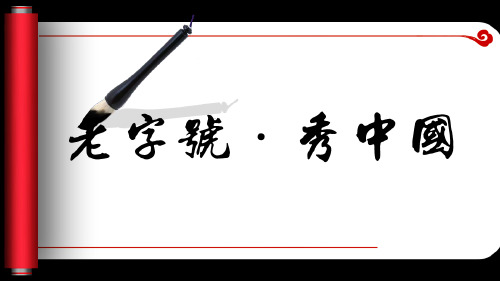
Ceramics and Culture
The pottery in the Neolithic e pottery in the Neolithic (8,000-2,000BC in China) period records the survival will of the ancient people. Pigs, dogs, and cows made of clay signified people's fierce struggle with the environment at the time。
Ming Plain Tri-colored Glazed Porcelain
During the Zhengde reign of the Ming Dynasty (1368-1644), a type of colored-glazed porcelain featuring three major colors -- yellow, green and purple -became very popular in Jingdezhen, Jiangxi Province.
Classic Work of Painted Pottery
The classic one is Human Face and Fish Body Design Colored Pottery Basin, which was made in the Neolithic age (5000 to 10000 years ago) and unearthed in the 1950s in Banpo Village in Xi'an of Shaanxi Province.
Noted Ceramics
介绍陶瓷(英文版)

7、The Han Dynasty( 206BC-220AD): Multi-colored(综合彩)glaze was also introduced in . 8、The Sui Dynasty(581-618):Greater variety and color.
9、TheTang Dynasty( 618-907 ) :More color was applied them in ,the invention of potters who introduced white, yellow, blue, green, brown, purple and so on.
Noted Ceramics
White Pottery
White pottery is a kind of pottery whose outside and inside are all white. The greenware(陶胚) is mostly made by hand. It uses porcelain clay or kaolinite, which contain less iron than figuline, and is fired at a temperature of about 1000 ℃. In the late Shang Dynasty (13th century - 11th century 成温度 瓷器
700-1000℃ 1200℃以上
原 材 料 诞生年代
一般用粘土
瓷土、高岭土
瓷器比陶器晚几千年
Development of Pottery
1、The existence of pottery was a hallmark of the Neolithic Age(新石器时代)in primitive society. 2、More than 10,000 years ago :Pottery shards(陶瓷碎片)were discovered in Jiangsu Province. 3、7,000 years ago:The site of the Hemudu Culture in Zhejiang Province could made Grey pottery, red pottery.
- 1、下载文档前请自行甄别文档内容的完整性,平台不提供额外的编辑、内容补充、找答案等附加服务。
- 2、"仅部分预览"的文档,不可在线预览部分如存在完整性等问题,可反馈申请退款(可完整预览的文档不适用该条件!)。
- 3、如文档侵犯您的权益,请联系客服反馈,我们会尽快为您处理(人工客服工作时间:9:00-18:30)。
It is known for its white porcelain.
influence
For some royal nobles, the collection and use of fine Chinese porcelain is a symbol of their worship of civilization and the pursuit of elegance and even the display of power. Both Washington and Jefferson had their own Chinese porcelain wares. Louis XIV, king of France, had a porcelain palace, which had a collection of Chinese porcelain. China also has a great influence on the social life of Indian people, especially the food culture.
器度
制作人:许瑶
讲解人:
Chinese cultural symbols
地师161
china(瓷器)
1. Introduction 2. Classification of china 3. Infulence
Introduction
China is the hometown of porcelain, and porcelain is an important creation of Chinese working people.
The invention of porcelain was the great contribution of the Chinese nation to the world civilization.
In English, "China" and "China" were the same words. In the middle of the shang dynasty in the 16th century B.C., early porcelain appeared in China.
Classification of china
The most famous historical kiln sites were the Jun Kiln, the Ge Kiln, the Guan Kiln, the Ru Kiln and the Ding Kiln.
It was covered with big and small lobes.
